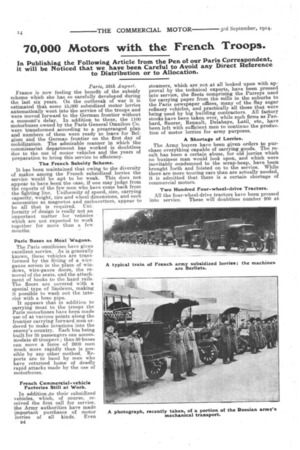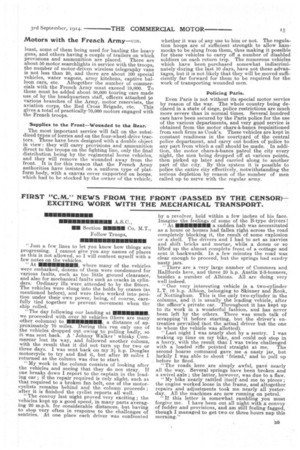70,000 Motors with the French Troops.
Page 14

Page 15

If you've noticed an error in this article please click here to report it so we can fix it.
In Publishing the Following Article from the Pen of our Paris Correspondent, it will be Noticed that we have been Careful to Avoid any Direct Reference to Distribution or to Allocation.
Paris, 28th, August.
France is now feeling the benefit of the subsidy scheme which she has so carefully developed during the last six years. On the outbreak of war it is estimated that some 15,000 subsidized motor lorries automatically went into the service of the troops and were moved forward to the German frontier without a moment's delay. In addition to these, the 1100 motorbuses owned by the Paris General Omnibus Co. were transformed according to a prearranged plan and numbers of them were ready to leave for Belgium and the German frontier on the first day of mobilization. The admirable manner in which the commissariat department has worked is doubtless due to the use of motor vehicles and the years of preparation to bring this service to efficiency.
The French Subsidy Scheme.
It has been maintained that owing to the diversity of makes among the French subsidized lorries the service would be apt to be weak. This does not appear to have been the case, if one may judge from the reports of the few men who have come back from the fighting line. Uniformity of speed, size, carrying capacity, weight, tire and wheel dimensions, and such accessories as magnetos and carburetters, appear to be all that is required. Uniformity of design is really not an important matter for vehicles which are not expected to work together for more than a few months.
Paris' Buses as Meat Wagons.
The Paris omnibuses have given excellent service. As is generally known, these vehicles are transformed by the fitting of a wiregauze screen in the place of windows, wire-gauze doors, the removal of the seats, and the attachment of hooks to the hand rails. The floors are covered with a special type of linoleum, making it possible to wash out the interior with a hose pipe.
It appears that in addition to carrying meat to the troops the Paris motorbuses have been made use of at various points along the frontier carrying forward men ordered to make invasions into the enemy's country. Each bus being built for 35 passengers can accommodate 40 troopers ; thus 50 buses can move a force of 2000 men much more rapidly than is possible by any other method. Reports are to hand by men who have returned home of deadly rapid attacks made by the use of motorbuses.
French Commercial-vehicle Factories Still at Work.
In addition to their subsidized vehicles, which, of course, received the first call for service, the Army authorities have made important purchases of motor lorries of all kinds. Even D4 steamers, which are not at all looked upon with approval by the technical experts, have been pressed into service, the fleets comprising the Purreys used for carrying paper from the mills in the suburbs to the Paris newspaper offices, many of the Say sugar refinery vehicles, and practically all those that were being used by big building contractors. All factory stocks have been taken over, while such firms as Panhard, Saurer, Renault, Delahaye, Latil, etc., have been left with sufficient men to continue the production of motor lorries for army purposes.
A Shortage of Lorries.
The Army buyers have been given orders to purchase everything capable of carrying goods. The result has been a certain abuse, for old lorries which no business man would look upon, and which were inevitably condemned to the scrap-heap, have been brought forth and foisted on to the service. While there are more touring cars than are actually needed, it is admitted that there is a certain shortage of commercial motors.
Two Hundred Four-wheel-drive Tractors.
All the four-wheel-drive tractors have been pressed into service. These will doubtless number 200 at least, some of them being used for hauling the heavy guns, and others having a couple of trailers on which provisions and ammunition are placed. There are about 50 motor searchlights in service with the troops, the number of motor-driven wireless telegraphy vans is not less than 20, and there are about 100 special vehicles, water wagons, army kitchens, captive balloon cars, etc. Altogether the number of commercials with the French Army must exceed 19,000. To these must be added about 50,000 touring cars made use of by the headquarters staff, officers attached to various branches of the Army, motor reservists, the aviation corps, the Red Cross Brigade, etc. This gives a total of practically70,000 motors engaged with the French troops.
Supplies to the Front—Wounded to the Rear.
The most important service will fall on the subsidized types of lorries and on the four-wheel-drive tractors. These have been designed with a double object in view : they will carry provisions and ammunition direct to the troops on the fighting line, only the final distribution being by the regimental horse vehicles, and they will remove the wounded away from the front. It is for this reason that the French Army authorities have insisted on a uniform type of platform body, with a canvas cover supportedon hoops, which had to be stocked by the owner of the vehicle,
whether it was of any use to him or not. The regulation hoops are of sufficient strength to allow hammocks to be slung from them, thus making it possible for these vehicles to carry off a number of disabled soldiers on each return trip. The numerous vehicles which have been purchased somewhat indiscriminately during the last 10 days, have not these advantages, but it is not likely that they will be moved sufficiently far forward for them to be required for the work of transporting wounded men.
Policing Paris.
Even Paris is not without its special motor service by reason of the war. The whole country being declared in a state of siege, police restrictions are much more severe than in normal times. Several hundred cars have been secured by the Paris police for the use of the various departments, and very good service is obtained from the motor chars-iabancs requisitioned from such firms as Cook's. These vehicles are kept in constant readiness in the courtyard of the central police department, and carry out bodies of police to any part from which a call should be made. In addition, the motor chars-iabancs patrol the city every night, the men being dropped off at various points, then picked up later and carried along to another part of the city. By this system it is possible to police the entire city effectively, notwithstanding the serious depletion by reason of the number of men called up to serve with the regular army.


















